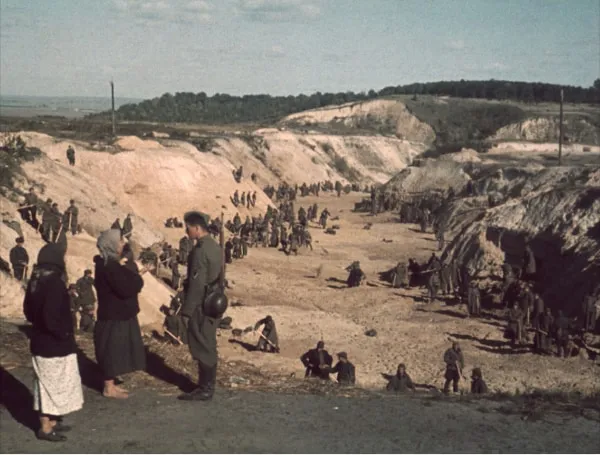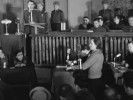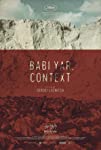Eye For Film >> Movies >> Babi Yar. Context (2021) Film Review
Babi Yar. Context
Reviewed by: Anne-Katrin Titze

Sergei Loznitsa’s remarkable Babi Yar. Context, which screened this week at the 74th Cannes Film Festival, is a work of resurrection which seems to collapse time. The film was produced for the Babyn Yar Holocaust Memorial Center and consists entirely of archival footage surrounding the tragedy. Official documentation, mixed in with private footage, shot by soldiers and civilians, chronicle the events following the German occupation of Ukraine.
Babi Yar is the name of a ravine in Kyiv, where on September 29 and 30, 1941, 33771 Jews were shot dead by Sonderkommando 4a of the Einsatzgruppe C, assisted by two battalions of the Police Regiment South and Ukrainian Auxiliary Police. The march of the entire Jewish population - everyone from old people to babies - heading to the ravine, took place in broad daylight and was witnessed by thousands. No footage remains and it was in the perpetrators’ interest to let the massacre sink into the sands of time.

The way June 1941 is presented here, the looming warfare seems to happen in the present. A bomb, a bridge over a river, people running. More bombs go off, horses whinny, dogs bark, black smoke rises from villages on fire. The pristine quality of the images (restoration by Jonas Zagorskas) and the carefully chosen soundtrack make it all look incredibly now. The air is dense with smoke, there are geese next to the burning farm and planes up high. People look up, things are about to change. A special radio broadcast for the citizens of the Soviet Union tells them so.
Tanks after tanks arrive on country roads. They stop in a village where children bring wildflowers to the Nazi soldiers. They are regarded as liberators by those who experienced Stalin’s agriculture policy which had caused mass starvation. The soldiers look relaxed, driving on sandy roads, and tomorrow the whole world, they may be thinking. Loznitsa uses no voiceover, only a number of dates and places and facts give us background. The rest is done by the choices in the editing of the footage (with Danielius Kokanauskis and Tomasz Wolski), the exquisite sound design (by Vladimir Golovnitski), the ample room we are given to look and think and feel and think again. The gigantic wound at the heart of the film is the heart of memory.
The confusion triggered often is confusion of the best kind because it mirrors the confusion we all feel when confronted with a new and unexpected situation. A German soldier counts people taken prisoner, 25 get in the back of each truck. Who are these men? Where are they transported to? This man sitting there, quietly waiting for his turn, does not know what will happen next. Loznitsa pushes us to be there with him, if only for a second. This is the film’s great strength and although the method could be located at the exact opposite end of Claude Lanzmann’s approach, which completely foregoes all archival footage to let the past speak in the present, the effect is the same. Past and present merge. Faulkner’s famous lines are truer than ever: “The past is never dead. It's not even past”.
Horses are grazing, women rebuilding in rubble, the landscape is calm. We see clouds, we see corpses of men and a long, long caravan of prisoners of war. Long lines of people walking. The whole film is made up of long lines of people walking - soldiers, prisoners, a parade - functioning as a constant reminder of the long procession of Jews walking to the ravine of which there exist no photos, no films, no images at all. Babi Yar was meant to be forgotten, given over to oblivion, as if it never happened. This documentary makes the spectres return in the walking men and women and children. The reality of war is also in those lines and the lines of tanks crawling through the fields.
On June 30, 1941 German troops occupy the city of Lvov/Lemberg with crowds cheering in the streets. German authorities order Ukrainian militia to gather local Jews at the prison where the Soviet Secret police had executed prisoners before their departure. The Jewish population is accused of collaboration. The archival footage shows chaos, a pockmarked building, smoke rising from the top floor, bodies being carried out. Women and men with brushes and brooms seem to attempt to clean the corpses or brush off debris. Several men and women beat others with sticks, a woman is dragged by her hair, a horrible mob descends on half-naked people. The point is, we can’t see any difference, no rhyme or reason. This is a man beating another man! There is no Other. This is all us, this is humanity.
By the river, women shovel and dig what looks like a long grave or a moat. Soviet soldiers taken prisoner have the faces of children, their features show the far reaches to the East. There is footage of German troops arriving in a village. One of them opens a window and climbs into a house. Another house is burning already. Are there people still inside? One soldier holds a contraption in his hands; for an instant you may think it could be a fire extinguisher, until you realize, no this is like Montag from Fahrenheit 451. He uses a flamethrower. One man smiles, they stroll casually away at a leisurely pace, as the world is burning.
July 1941, Kyiv looks busy, yet calm. Some cars, a crowded tram, a beautiful, peaceful city. Kids play with a dog by the star-shaped metal barriers. Other children help shovelling to fill sandbags. Three nurses walk by. The war is still abstract for a city preparing for war. Loznitsa lets us return twice more to Kyiv in the course of the film and the differences are startling. The other place visited more than once is Lvov/Lemberg. The parade in August ’41 to celebrate the new Governor General Hans Frank, with girls in Ukrainian costumes and swastikas lining the streets, will later be followed by a waving population welcoming the Soviet troops in July ’44.
On September 19, 1941, German troops occupy the city of Kyiv. What we see is a far cry from the peaceful atmosphere of two months earlier. In a prisoner of war camp near the city, women pick up their husbands. They smile for the camera, relieved to “go back and work for the benefit of the German Reich” as they sign the release papers. A cute toddler looks on as his father changes clothes for the way home.
September 24, 1941, bombs go off in the city, half of which seems to be burning now. This is the trigger, the excuse. German authorities in response to the explosions make the decision to exterminate the entire Jewish population of Kyiv. The notice proclaimed that they were to gather on Monday, September 29, 1941, at 8AM at a specific street corner near the cemetery and bring with them “IDs, money, valuables, as well as warm clothing, underwear etc.” and that those who disobeyed and were found elsewhere would be shot dead, as would be citizens found breaking into the vacated flats. This is the midpoint of the film. The abyss opens. A pile of boots, clothing, birdsong. Baby shoes, more clothes, a wooden leg. No bodies to be seen. A local newspaper on October 5, 1941, publishes an article stating that “Kyivliberated from Oriental barbarians breathes freely and begins a new life”.
In November 1943 a group of American journalists visits Babi Yar. People gather in the ravine. A woman speaks of the killings and how POWs had to dig up the corpses to be burnt. A man explains that these men were also to be killed. Only 12 escaped to tell the truth. The war is still not over, more bombs in the night and dead soldiers in the frozen landscape. Footage of planes and aerial shots read so differently from those sleek documentaries that play with simulated games of warfare. There is nothing thrilling about crashed planes, dead bodies in the snow with family photos scattered around them.
The leaps in time make perfect sense, because when we hear witnesses testify about the atrocities during a trial in January 1946, linear time collapses again in front of our eyes. When Hans Isemann of the SS division Viking speaks, his face is that of a young man you could encounter on the street in 2021. His testimony is factual; without any emotion he recounts his role and that he shot 120 people in Lemberg.
Witness Dina Pronitcheva, who survived Babi Yar, buried alive in the mass grave, and managed to crawl out to safety, gave testimony on January 24, 1946. (The film does not mention this, but she worked after the war as a puppeteer in the State Puppet Theatre, located in what used to be one of the biggest synagogues in Kyiv.) Five days later, a public execution of 12 perpetrators took place in the centre of Kyiv. The footage shows a mass of people surrounding the gallows on a square. The public hanging feels at once medieval and simultaneously resembles an over-flowing crowd gathered for a soccer match. Loznitsa takes time to show the masses trying to get a glimpse of the bodies. From above it looks like an anthill.
In 1952, the city council filled the Babi Yar ravine with industrial waste from a local brick factory. Construction is going up around it. There is again birdsong, a forest. Loznitsa resists a jump to the present. There is no need, we jump on our own. The post-war history of forgetting and remembering and forgetting again is a different aspect, that would distract from the direct link between then and now the film manages to establish. 80 years are nothing. Time folds in on itself. What happened on September 29 and 30, 1941, in Babi Yar has everything to do with each of us right now. The precision of the number always struck me, 33771. It is the one in the end that resists abstraction and pulling us out of abstraction and into the concrete is the aim of Babi Yar. Context.
Reviewed on: 17 Jul 2021















